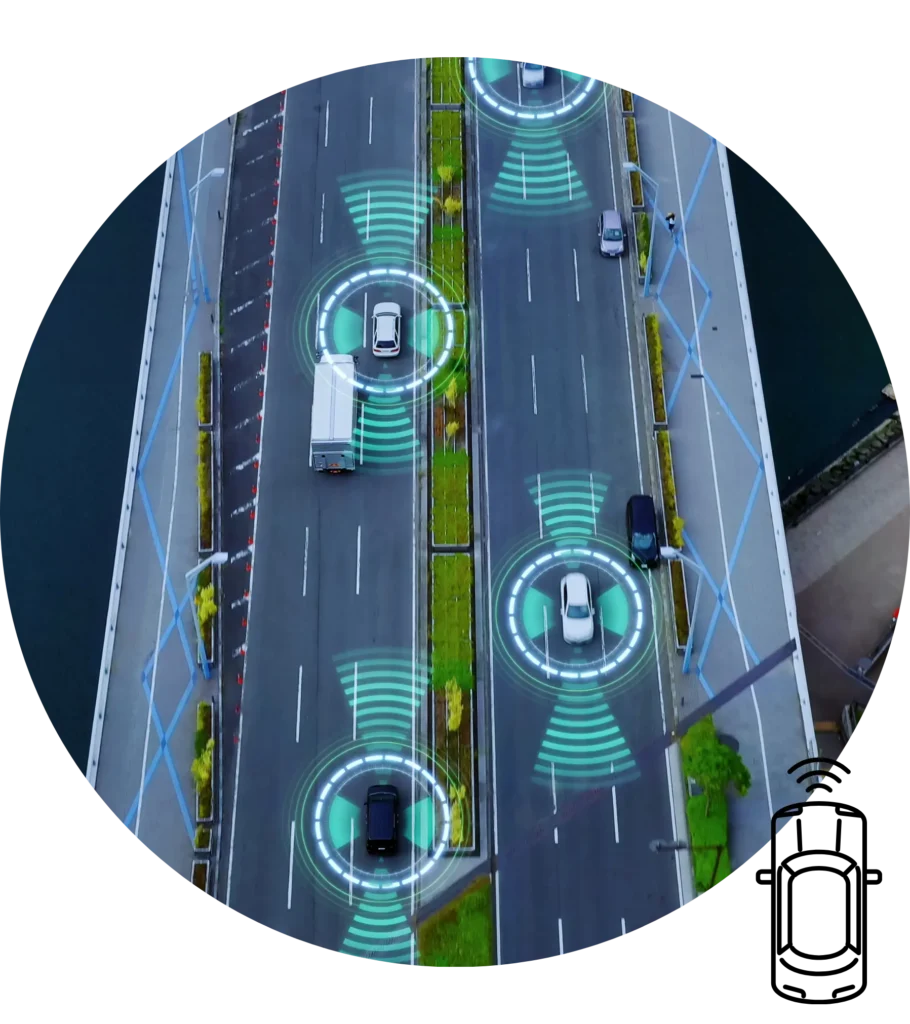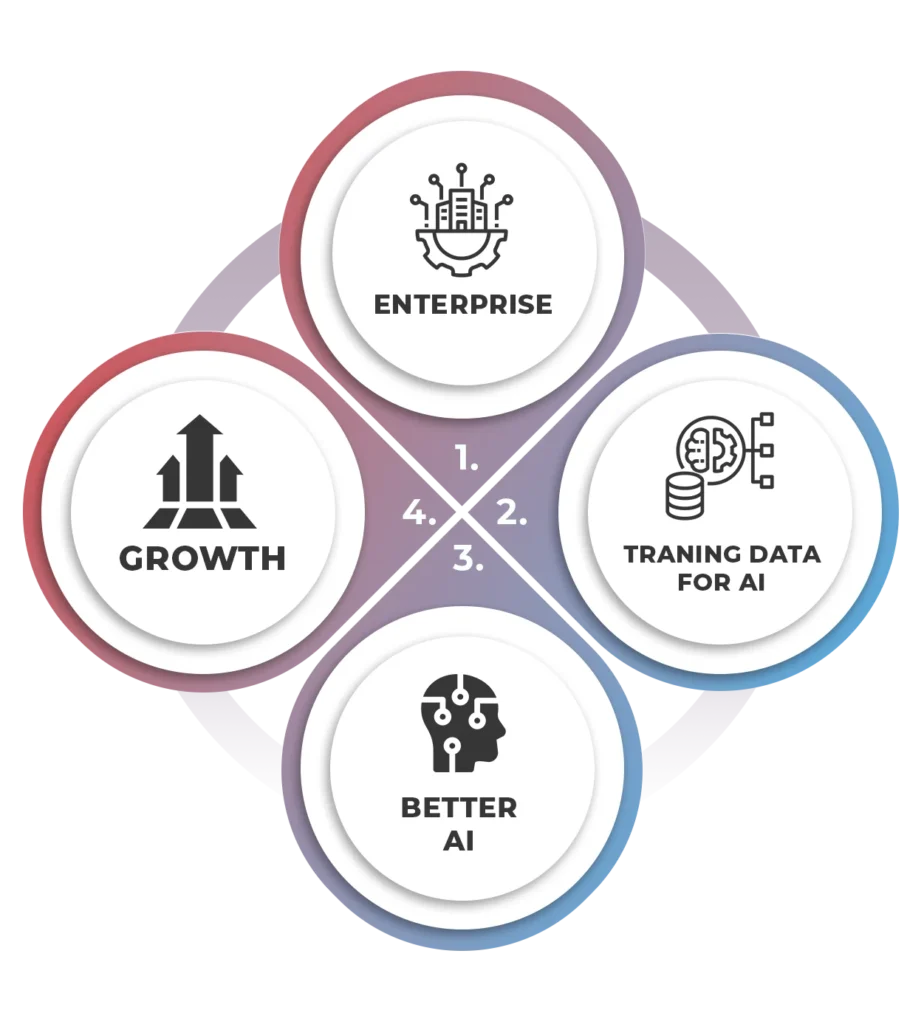Reliable ADAS Training Data Collection for Accuracy
Our ADAS training data - The standard for mapping the path to safety. Let's Connect to explore more
Ensuring Automotive Safety with Advanced Driver Assistance Systems (ADAS)
Exploring the Potential of Computer Vision through ADAS for Smarter Driving Experiences

Embarking on a journey towards safer roads and intelligent transportation, Advanced Driver Assistance Systems (ADAS) employ the power of computer vision to reimagine the driving landscape. As wireless network connectivity becomes more common, next-generation ADASs will use it to provide better value.Some ADAS features have become so popular and well-established that they have become popular in various regions of the world. The ease and comfort of drivers and passengers as well as prevention and avoidance of accidents and injuries are all included in today’s ADAS features.
Unlike human drivers, ADAS-equipped machines analyze countless road scenarios in real-time, fostering a paradigm shift in automotive safety and efficiency. However, the installation of cameras in cars requires the development of entirely new artificial intelligence (AI) systems that can detect and evaluate objects using sensor fusion. Large volumes of data can be merged via image recognition software, lidar, radar, ultrasonic sensors, and sensor fusion. Physically responding quicker than a human driver, this technology analyzes live-streamed footage, deciphers what it sees, and decides how to respond.
Transformative Impact of ADAS on Driving Dynamics
ADAS revolutionizes how vehicles perceive and interact with their environment, primarily driven by the following factors:

Safety & Automation
ADAS revolutionizes visual task automation, diminishing reliance on human intervention, thus fortifying collision avoidance, lane-keeping, and adaptive cruise control processes. This technological evolution promises heightened safety and efficiency in automotive operations.

Emergency Response
ADAS systems enhance emergency response in crashes by delivering real-time data, enabling faster and more precise deployment of emergency services. This improves incident management and bolsters passenger safety through advanced information and coordinated strategies.

Accessibility and Inclusivity
ADAS contributes to creating a more inclusive driving experience by assisting individuals with varying mobility levels and fostering a safer and more accessible road environment. It offers automatic emergency braking and blind-spot detection, enhancing overall road safety.

Informed Decision-Making
Real-time insights provided by ADAS empower drivers and fleet managers with informed decision-making capabilities. This technology enhances awareness, leading to safer and more efficient journeys for drivers while providing data for optimizing overall fleet performance as well.

Advanced Connectivity
ADAS's integration with advanced connectivity features enhances communication between vehicles and infrastructure. This results in dynamic traffic management, optimized routing, and collective data sharing, ultimately improving overall road efficiency and reducing congestion.

Personalized Driving Experience
ADAS tailors driving experiences through personalized settings and preferences. From adaptive lighting to intelligent climate control, this technology ensures a comfortable and customized journey for each driver, promoting user satisfaction and brand loyalty.
Key Applications of ADAS

Collision Avoidance Systems
ADAS employs computer vision to detect potential collisions and initiate preventive measures, such as automatic emergency braking, reducing the risk of accidents.

Lane-Keeping Assistance
Computer vision enables vehicles to stay within their lanes by monitoring lane markings and providing corrective steering inputs when needed.

Pedestrian and Cyclist Detection
ADAS contributes to road safety by detecting pedestrians and cyclists, issuing warnings, and triggering braking systems promptly to prevent collisions.

Traffic Sign Recognition
Computer vision in ADAS interprets and recognizes traffic signs, providing drivers with real-time information about speed limits, stop signs, and other crucial road directives.

Adaptive Cruise Control
ADAS optimizes driving speed by adjusting to traffic flow, maintaining a safe following distance, and effectively reducing driver fatigue for enhanced road safety.

Blind-Spot Detection
ADAS enhances driver awareness using advanced sensors to detect vehicles in blind spots. Alerts notify drivers of potential dangers during lane changes.
How Can We Advance Your ADAS Models?
As the quality of data is paramount in developing robust ADAS models, it stands as a trusted partner to enhance your automotive safety initiatives. Here’s how our AI data services can contribute:

Precision in Training
Our meticulously high-quality data ensures that ADAS models are trained on diverse and representative scenarios, optimizing their accuracy in real-world conditions.

Bias Reduction
We provide meticulously curated datasets, minimizing biases and ensuring a balanced representation of data, fostering fair and ethical ADAS practices.

Real-World Application
Leveraging our data, your ADAS models gain practical exposure, increasing the likelihood of delivering meaningful and reliable results in diverse driving scenarios.

Robustness Testing
We consider various driving scenarios, including edge cases, to enrich ADAS models against challenging conditions, ensuring adaptability to real-world elements.

Continuous Learning
Our AI services support continuous learning for ADAS models, enabling adaptive systems that evolve with changing driving patterns, ensuring sustained effectiveness.

Scalability and Efficiency
Our scalable solutions meet ADAS development demands, providing efficient data processing and annotation for seamless scalability ensuring effective model evolution.
How is LiDAR crucial in ADAS technology?
LiDAR (Light Detection and Ranging) technology enhances Advanced Driver Assistance Systems (ADAS) in many ways. When combined, they improve safety and performance in the automotive industry. Hence, by offering precise and thorough environmental data, LiDAR technology significantly contributes to the improvement of ADAS capabilities. Modern cars with advanced driver-assistance systems are safer and more dependable due to their capacity to supply accurate data for tracking, object identification, and environmental mapping.
Here are several ways LiDAR can enhance ADAS technology:
LiDAR sensors enable high-resolution 3D mapping of the car's surroundings. Its exceptional accuracy allows for precise item recognition and monitoring, including cars, pedestrians, and barriers. As a result, ADAS features like accident avoidance and automated emergency braking are now more efficient.
Ensuring precise measurement of the distance between the vehicle and nearby objects is essential for ADAS applications. It helps the system make more dependable decisions. LiDAR provides remarkable accuracy in measuring distance and helps precisely determine depth perception.
LiDAR sensors generate precise point cloud maps of the surroundings, providing a wealth of contextual data. This degree of environmental mapping is essential for ADAS applications that depend on a comprehensive knowledge of road and traffic events like adaptive cruise control and lane-keeping assistance.
LiDAR is effective in low-light conditions, such as nighttime or adverse weather scenarios, where traditional sensors like cameras may face challenges. This capability ensures consistent object recognition and tracking, enhancing the reliability of ADAS features under diverse environmental conditions.
LiDAR sensors provide an additional layer of redundancy to existing sensor technologies in ADAS, such as cameras and radar. This redundancy enhances safety by mitigating the risk of sensor failures or limitations in specific situations.
LiDAR's precision range capabilities support the vehicle's precise lane-level positioning. It is necessary to guarantee that the car stays in the proper lane on the road for ADAS features like lane-keeping assistance and lane departure warning systems.
When paired with additional sensor inputs, LiDAR data helps to improve the accuracy of object classification. This is advantageous for differentiating things, such as differentiating pedestrians from other cars and enhancing ADAS algorithms' ability to make decisions.
Because LiDAR may give high-frequency, real-time data in real-time, ADAS systems can anticipate the paths of dynamic objects like pedestrians and moving cars. This predictive capability improves a vehicle's ability to anticipate and react to possible risks.
In applications involving autonomous driving, LiDAR is a vital sensor. The capabilities of LiDAR contribute to the underlying technologies required for better driver-assistance features that pave the path for autonomous driving, even though full autonomy is a more advanced aim.

Uses of RADAR in ADAS
“RADAR” (Radio Detection and Ranging) is used in Advanced Driver Assistance Systems (ADAS) to enhance driving abilities and safety in cars. ADAS incorporates several features and technology to improve overall vehicle safety and assist drivers.
Here’s an explanation of RADAR for ADAS:
Object Detection and Tracking
ADAS RADAR technology precisely detects and tracks objects such as vehicles, pedestrians, and barriers by sending out radio waves and calculating return time to determine distance and speed, thus enhancing car safety and collision prevention.

Avoiding Collisions
RADAR prevents collisions by giving real-time information on the proximity of objects in the vehicle's surroundings. The ADAS system can detect approaching collisions and initiate automated braking or alarms to prevent or lessen the impact.

ACC, or adaptive cruise control
Adaptive cruise control systems integrate RADAR to maintain a safe following distance from the vehicle ahead. Utilizing RADAR sensors, ACC automatically adjusts the vehicle's speed, ensuring a secure and adaptive driving experience.

The Blind Spot Identifier
RADAR sensors are pivotal in advanced blind spot detection, promptly notifying drivers of cars in adjacent lanes not visible inside mirrors. The sophisticated device ensures proactive alerts if a vehicle is detected in its blind spot, significantly enhancing road safety measures.

Alert for Cross Traffic
Using RADAR technology, cross-traffic alert systems notify motors of oncoming traffic while backing out of parking spaces. This complements protection via stopping collisions and provides further awareness for drivers at some point of maneuvering, ensuring a more secure user experience.

Lane-Changing Assistance
RADAR sensors contribute vital data to lane change assist systems, assisting drivers during lane changes by providing valuable information about nearby lanes. This boosts driver awareness, ensuring safer and more informed maneuvers on the road, aligning with advancements in automotive safety technology.

Help With Parking
RADAR-based parking assistance systems adeptly detect obstacles during parking maneuvers, providing the driver with crucial visual or audible indicators. This technology significantly enhances safety by offering real-time assistance and effectively mitigating the risk of collisions in tight parking spaces.

Warning of Forward Collision
RADAR enhances forward collision warning systems by detecting relative speed and distance from cars or obstacles ahead, alerting drivers to potential collisions. Collaborating with cameras and LIDAR, this multi-sensor approach improves ADAS robustness and dependability across diverse driving circumstances and scenarios.

Intersection Safety
RADAR plays a crucial role in intersection safety within ADAS. It helps detect and track vehicles approaching an intersection, providing real-time data to the system. This information aids collision prevention by alerting drivers or triggering automated responses to ensure safe intersectional navigation.
Explore Our Data Services for ADAS
Macgence offers comprehensive support at every stage of your ADAS project:

Data Collection
Partnering with Macgence accelerates ADAS models' large-scale data collection, ensuring the efficient development of robust data pipelines. This collaboration enhances reliability and performance in advancing your systems.

Data Annotation and Enhancement
Elevate your ADAS models with precise data annotation and enhancement services. Our expertise ensures the accurate identification of objects, enhancing the capabilities of your models for behavior prediction.
Wanna talk
Don’t hesitate to Contact with us for inquiries!
As we understand your business is mostly about Data, we not only Provide human generated data we transform business in the world with human generated services.
Get In Touch
Info@macgence.com

Choose Macgence to Drive Innovation in ADAS
Companies need high-quality ADAS data to focus on real-world context, refine object detection models, handle complex scenarios, and consider critical factors such as sensor fusion, data annotation, data volume, diversity, privacy, and ethics. These datasets, in turn, make the development of AI systems that enhance driving experience, improve safety, and encourage the use of driverless vehicles. Macgence is committed to assisting you in achieving your safety goals by providing top-notch AI training data. Our dedication to the quality and diversity of data ensures the robustness of your ADAS models, laying the foundation for safer and smarter driving experiences.
Macgence uses ethical data collection methods, in addition to providing quality AI training data. We prioritize data governance, AI policies, and current data strategies for superior data quality.
